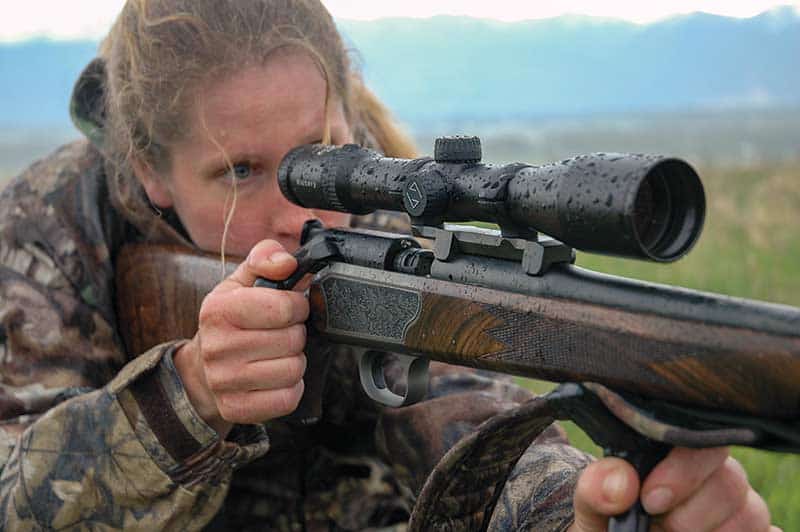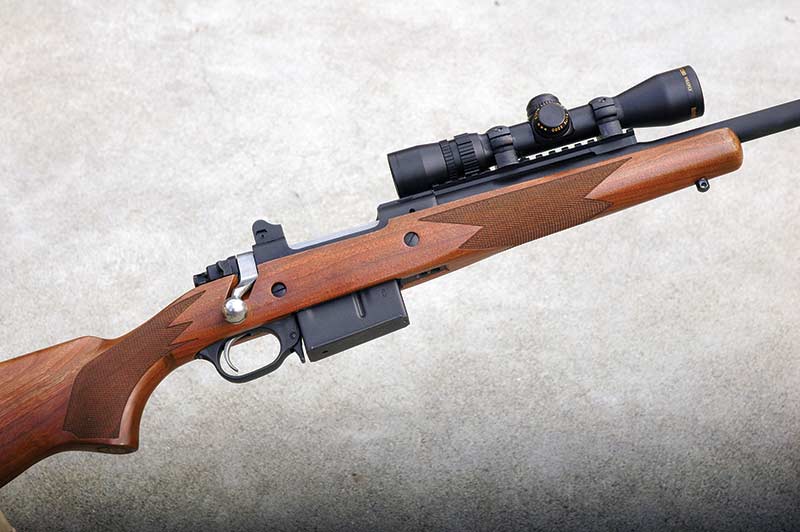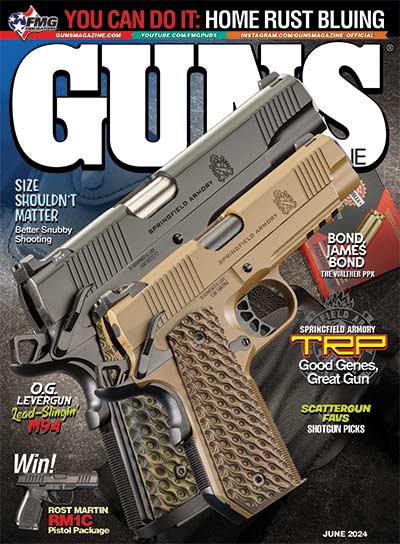The Optical Triangle
Eye Relief, Field Of View And Magnification
It’s not as inscrutable as the Bermuda Triangle. Shooters who ignore it won’t disappear. But the three legs of the optical triangle do affect what you see through a lens and how fast you can put that view to use. Favor one leg, and the others may deny you a view — or bang you on the brow to get your attention.
Eye Relief
Eye relief is the distance between the rear (ocular) glass of an optical instrument and your eye. It is a specification for optics because it’s built into them. Rifle scopes made for receiver mounting have 3″ to 4″ of ER. You may have heard someone whimper: “Too little eye relief,” as he presses washcloth to brow to stanch the hemorrhage. Whatever the intended implication, the scope bears no blame; his eye was simply too near the sight when he fired. Either he installed the scope too far aft in the rings or didn’t hold the rifle firmly and rock with it during recoil.
The arc of scar tissue above my right eye is a souvenir from many scopes. None had insufficient ER. Many were on rifles I was asked to fire a few times for reviews. They had been snugged in place by people with shorter arms than mine, people who don’t crawl a stock or routinely fire prone, people who never fire uphill at game, people who insist a scope is best positioned so the rings bisect the free tube either side of the turret, no matter how far the ocular bell protrudes over the stock’s comb.
These days, I take the time to move these scopes forward or, for brief bench sessions, add length to the stock with a section of 2×4 swathed in a towel. Modern variable scopes with long eyepieces annoy me because many preclude placing the scope far enough forward. An extension ring is a useful option, if not cosmetic nirvana.
Handgunners require scopes with long ER because the pistol or revolver is held at arm’s length. A long-eye-relief scope for this purpose has a very small field of view. Top-ejecting lever rifles, scout rifles and some take-down models require intermediate-eye-relief scopes that mount on the barrel forward of the receiver.
Generous latitude in ER is a good thing because, whatever the specified measure, you’ll want to see a rim-to-rim field if your eye isn’t exactly that distance from the lens. ER is more critical in scopes of high magnification. Also, it typically shrinks slightly as you dial up the magnification in variable scopes. This is an undesirable trait, so some variables are claimed by their makers to show no change in ER. On the other hand, most shrinkage is barely noticeable. For example, in my Leupold 3-9x scopes with 1″ and 30mm tubes, 40mm and 50mm objective (front) lenses, ER at 3x is 4.17″; at 9x it’s 3.66″.
Binoculars and spotting scopes have just a few millimeters of ER, as these optics don’t pop you on the noggin while you’re peering through them.
Field Of View
Field of view (FOV) is typically listed as an angle or, for binoculars and spotting scopes, as width in feet at 1,000 yards or meters at 1,000 meters. For rifle scopes, FOV usually appears as feet at 100 yards or meters at 100 meters. Contrary to popular myth, FOV has essentially nothing to do with objective lens diameter. Nor does it depend on tube diameters of rifle scopes.
Researching for my Gun Digest Book of Sporting Optics, I spoke with Bill Cross, whose career as an optical engineer yielded many fine products at Bushnell. “Physics forces trade-offs,” he said. “After we designed wide FOV into our 2-6x handgun scope, we found ER shrank to 12″ at the top power. No handgunner I know has arms that short! So we sacrificed some field to get 20″ of ER.” He told me he thought a wide FOV was over-rated in a sight.
Magnification
Magnification helps you spot or identify distant objects and sift details in thickets to find hiding game. It enables you to aim precisely, quartering a bullseye. You can nudge the crosswire incrementally to allow for bullet drop or into the wind to counter drift. But like fast cars and supermodels, magnification is not all virtue. It reduces the size of the field you see, as it appears to draw you nearer to what’s in it. As FOV shrinks, you see less and less around its center. Some of what you miss can be important.
Secondly, magnification requires that you temporarily re-wire connections between eye and brain. When a feature small to the naked eye becomes suddenly bigger, you must place it into context. Until you do that, the feature is something else. Look at a speck under a microscope, and you no longer see a speck, but a coffee ground, a small insect or a grain of volcanic ash.
Partly for this reason, I prefer a binocular with modest magnification — 7x or 8x. A 3x or 4x rifle scope has all the power I want for hunting game bigger than coyotes. Low magnification requires less of my brain as little objects become big and new detail appears in the FOV. While high-power lenses reveal more detail, they delay interpretation. Peering at a hair under a microscope, you’ll wonder briefly how that timber could fit on a slide.
Magnification also gobbles incidental light. Reflection and refraction from and within a lens snare some of that light, as much as 4% on each uncoated surface in a series of lenses inside an optic. Coating lenses with magnesium fluoride, a process credited to Zeiss during the 1930s, reduces that loss. Modern multi-coatings pare it further.
Viewing and aiming can become more difficult as you add magnification. It makes a binocular field jump about and the reticle in your rifle scope hard to control. Magnification doesn’t introduce those gyrations; it just makes them more visible. With a 20x scope in rimfire competition, standing offhand with no support gave me fits. Despite the mitigating influence of a shooting jacket and a heavy rifle, the crosswire was never still. Tiring muscles imparted more violence to the sight picture. Finally, in despair, I’d horse the trigger as the reticle swept by the 10-ring. Uncontrolled weeping ensued.
In a 4x scope, the target image is smaller; but the speed and amplitude of reticle movement are much reduced. You squeeze the trigger blissfully unaware of all but your rifle’s most violent tremors. A better shot results.
The best balance of eye relief, field of view and magnification depends on an optic’s purpose, and on how you use that glass. Bear in mind manufacturers can’t divine what will best serve you. Spreadsheets show only what’s most profitable.







